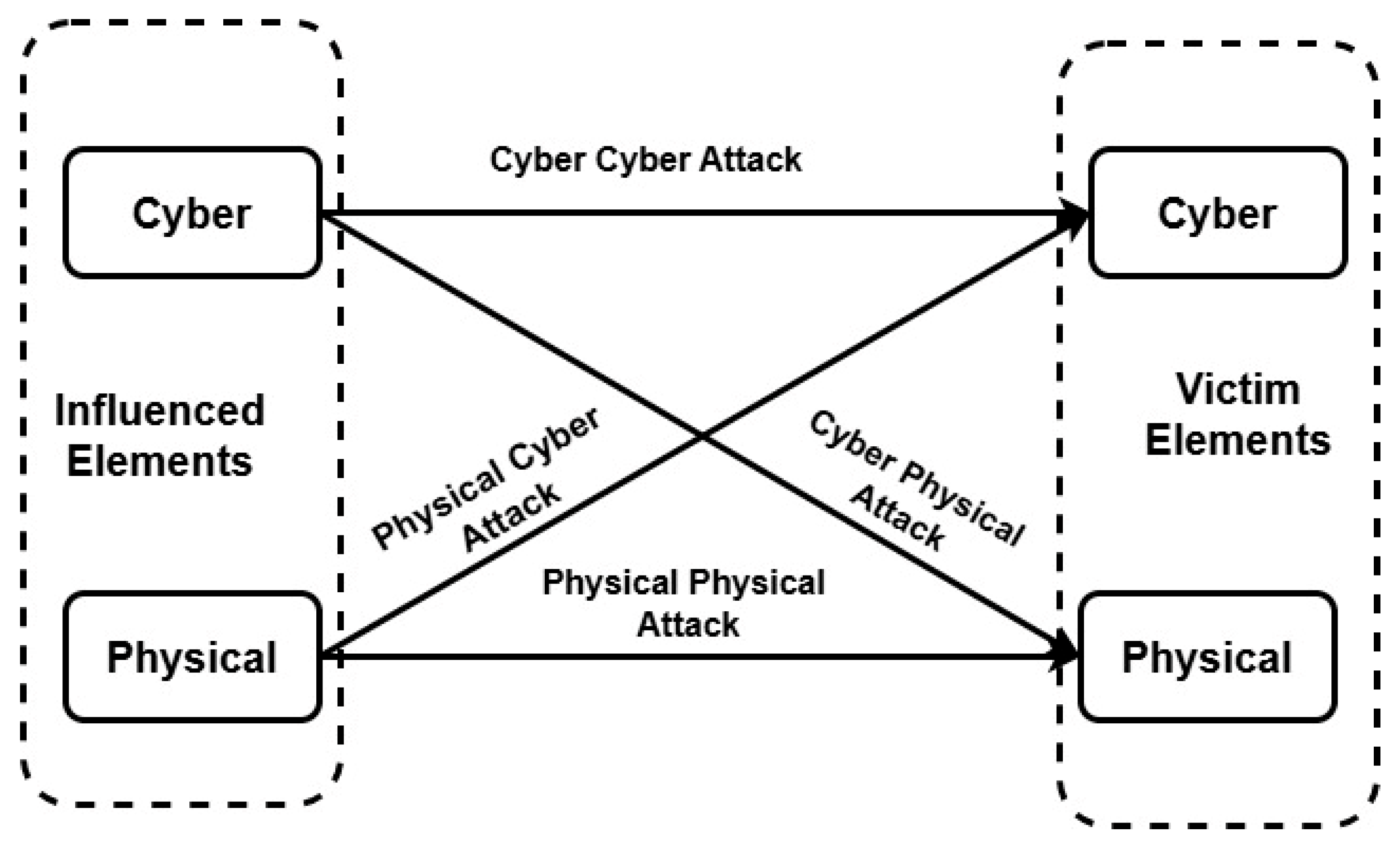Digital Twins, AI, and Cybersecurity in Additive Manufacturing: A Comprehensive Review of Current Trends and Challenges
Abstract
1. Introduction
2. Digital Twin Technology in Additive Manufacturing
3. Modular AI for System Reconfiguration and Optimization (AI/ML Algorithms)
4. Cyber Security in Additive Manufacturing
- STL or G-code file of the object produced in a lab environment.
- The audio signal was recorded during manufacturing.
- The audio fingerprint was calculated, encrypted, and appended to the G-code file.
5. Synergistic Integration of Digital Twins, AI, and Cybersecurity in Additive Manufacturing
5.1. Feedback-Driven Predictive Optimization
5.2. Adaptive Cybersecurity Through AI-Enhanced Monitoring
6. Challenges and Possible Solutions
6.1. Cybersecurity Vulnerabilities
6.2. Possible Solutions
- Shi et al. [95] proposed using side-channel data—such as acoustic signals and vibrations—in combination with AI-based anomaly detection to increase the accuracy of attack detection and hence support real-time monitoring operations.
- Blockchain technology is recommended for inclusion to create unalterable audit trails for important design files, including STL and G-code. Blockchain technology’s distributed ledger enables the verification of manufacturing operations’ legality by preventing unauthorized access and ensuring the authenticity of files throughout the production process [108,109].
- Developing advanced encryption techniques in conjunction with blockchain technology will help ensure the security of the transport and storage of design files and sensitive data.
6.2.1. AI-Driven System Reliability
- Regularly updating AI models with real-world data helps increase the accuracy of forecasts and flexibility in adapting to changing AM conditions.
- Using blockchain-based smart contracts can help AI become more dependable, as these contracts can automate model modifications and validate the integrity of training data. Haw et al. [110] and Westphal et al. [111] introduced a foundation of blockchain with a blockchain-based quality management system that ensures data traceability in AM. Lupi et al. [112] proposed a shared manufacturing approach leveraging blockchain for decentralized production validation. Additionally, Alkhader et al. [113] demonstrated a comprehensive framework for blockchain-enabled traceability and management in AM that reinforces the trustworthiness of AI-driven process improvements.
6.2.2. The Challenge in Combining Physical and Digital Systems
- Wang et al. [59] have proposed the application of modular AI frameworks that can adjust to unexpected environments, including material discrepancies.
- Traceability solutions by blockchain technology can closely track the whole production process, and this guarantees that the data obtained from sensors, DTs, and AI models is preserved in a safe manner and can be validated, therefore helping with system synchronization and the resolution of any potential errors [114,115,116,117,118,119].
6.2.3. High Costs and Resource Requirements
- Use cloud-based systems to lower starting costs and enable less privileged people to access highly performing technologies. Simeone et al. [124] focused on improving resource efficiency in additive manufacturing services via introducing a smart cloud manufacturing platform. Later on, Rahman et al. [125] proposed a cloud-based cyber-physical system that provides advanced manufacturing capabilities. Furthermore, Haghnegahdar et al. [126] highlighted the critical role of industrial IoT-based cloud approaches in democratizing intelligent additive manufacturing.
- Promote the creation of blockchain-based cooperative networks that enable small and medium-sized businesses to exchange resources and access verified manufacturing data, thereby reducing the cost of individual investments. Shared additive manufacturing model [112], blockchain integration with supply chain [119], and cognitive analytics framework [127] contribute to sustainability and resilience in e-commerce-driven additive manufacturing supply chains.
6.3. Shortcomings and Proposed Framework
6.3.1. Framework Overview and Architecture
6.3.2. Digital Twin Layer: Real-Time Process Replication and Simulation
- Real-time checking of in-process abnormalities (e.g., overheating, delamination, recoater failures),
- Predictive simulations handling finite element or reduced-order simulations for thermal and residual stress inference,
- Control validation by evaluating expected results against live sensor feedback.
6.3.3. AI Layer: Data-Driven Intelligence and Control Optimization
- Physics-Informed Neural Networks (PINNs) for explaining inverse problems such as rebuilding indefinite boundary conditions from partial thermal data [133].
- Deep learning models (e.g., CNNs, LSTMs) trained on prior process data to estimate defect formation, porosity zones, or layer-wise quality differences [134].
- Reinforcement Learning (RL) drivers learn to independently adjust laser power, scan speed, or hatch spaces in real time to enhance process results [135].
6.3.4. Blockchain Layer: Secure Traceability, IP Management, and Smart Contracts
- Generates a tamper-proof audit trail for build records, parameter changes, and failure events [136].
- Implements access control using smart contracts to guarantee only authorized personnel or collaborators can view/edit critical data [137].
- Enables IP protection by combining design files, toolpaths, and quality metrics to unique blockchain logs, preventing unauthorized access or modifications.
6.3.5. Middleware Orchestration: Real-Time Integration and Interoperability
- Event-driven interaction, allowing data triggers (e.g., thermal anomaly detection) to use blockchain transactions or AI-based control updates,
- Standardized data formats and ontologies for inferring sensor feedback, simulation outputs, and blockchain metadata throughout subsystems,
- APIs and microservices for integrating external systems, such as PLM systems, ERP tools, or connected manufacturing networks.
6.3.6. Implementation Cost Considerations
7. Conclusions
- This paper summarizes and critically analyzes multiple data-driven (DT) architectures for additive manufacturing (AM), including mechanical, control, and machine learning-based models, and discusses their role in in situ monitoring and process optimization.
- This paper reviews the role of dynamic and modular AI frameworks, including PINNs, CNNs, LSTMs, and RL algorithms, in adjusting real-time AM process parameters, such as laser power and scan speed, to optimize build quality.
- The paper proposes a holistic closed-loop architecture that combines a Digital Twin, AI, a blockchain network, and real-time middleware orchestration to enable intelligent control, predictive process optimization, and secure cyber-physical interaction in additive manufacturing (AM) production systems.
Author Contributions
Funding
Data Availability Statement
Conflicts of Interest
References
- Singh, M.; Fuenmayor, E.; Hinchy, E.P.; Qiao, Y.; Murray, N.; Devine, D. Digital Twin: Origin to Future. Appl. Syst. Innov. 2021, 4, 36. [Google Scholar] [CrossRef]
- Armstrong, M.; Mehrabi, H.; Naveed, N. An overview of modern metal additive manufacturing technology. J. Manuf. Process. 2022, 84, 1001–1029. [Google Scholar] [CrossRef]
- Tao, F.; Zhang, M.; Nee, A.Y.C. Digital Twin Driven Smart Manufacturing; Academic Press: Cambridge, MA, USA, 2019. [Google Scholar]
- Erol, T.; Mendi, A.F.; Dogan, D. Digital Transformation Revolution with Digital Twin Technology. In Proceedings of the 2020 4th International Symposium on Multidisciplinary Studies and Innovative Technologies (ISMSIT), Istanbul, Turkey, 22–24 October 2020; pp. 1–7. [Google Scholar] [CrossRef]
- Zuo, X.; Zhou, Y.; Hao, K.; Liu, C.; Yu, R.; Huang, A.; Wu, C.; Yang, Y. 3D Printed All-Natural Hydrogels: Flame-Retardant Materials Toward Attaining Green Sustainability. Adv. Sci. 2024, 11, 2306360. [Google Scholar] [CrossRef]
- Yao, S.; Chen, F.; Wang, Y.; Zhou, H.; Liu, K. Manufacturing defect-induced multiscale weakening mechanisms in carbon fiber reinforced polymers captured by 3D CT-based machine learning and high-fidelity modeling. Compos. Part A Appl. Sci. Manuf. 2025, 197, 109052. [Google Scholar] [CrossRef]
- Glaessgen, E.; Stargel, D. The Digital Twin Paradigm for Future NASA and U.S. Air Force Vehicles. In Proceedings of the 53rd AIAA/ASME/ASCE/AHS/ASC Structures, Structural Dynamics and Materials Conference, Honolulu, HI, USA, 23–26 April 2012; American Institute of Aeronautics and Astronautics: Reston, VA, USA. [Google Scholar] [CrossRef]
- Grieves, M. Back to the Future: Product Lifecycle Management and the Virtualization of Product Information. In Product Realization; Springer: Boston, MA, USA, 2009; pp. 1–13. [Google Scholar] [CrossRef]
- Zhang, Z.; Wan, L.; Wen, Q.; Shi, Y.; Feng, Z. Wire-based friction stir additive manufacturing of TiC reinforced Al-Cu-Mg composite: Particle refinement and dispersion. Compos. Part A Appl. Sci. Manuf. 2025, 196, 109009. [Google Scholar] [CrossRef]
- Ahn, D.-G. Directed Energy Deposition (DED) Process: State of the Art. Int. J. Precis. Eng. Manuf.-Green Technol. 2021, 8, 703–742. [Google Scholar] [CrossRef]
- Yang, H.; Wei, S.; Zhou, H.; Hu, F.; Chen, Y.; Hu, H. The Global Industrial Robot Trade Network: Evolution and China’s Rising International Competitiveness. Systems 2025, 13, 361. [Google Scholar] [CrossRef]
- Lim, K.Y.H.; Zheng, P.; Chen, C.-H. A state-of-the-art survey of Digital Twin: Techniques, engineering product lifecycle management and business innovation perspectives. J. Intell. Manuf. 2020, 31, 1313–1337. [Google Scholar] [CrossRef]
- Yu, H.; Zhao, Q.; Fu, J.; Hu, Y.; Liang, J.; Li, J.; Xu, W. The design of oxidation resistant Ni superalloys for additive manufacturing. Addit. Manuf. 2025, 97, 104616. [Google Scholar] [CrossRef]
- Zhang, L.; Chen, X.; Zhou, W.; Cheng, T.; Chen, L.; Guo, Z.; Han, B.; Lu, L. Digital Twins for Additive Manufacturing: A State-of-the-Art Review. Appl. Sci. 2020, 10, 8350. [Google Scholar] [CrossRef]
- Gaikwad, A.; Yavari, R.; Montazeri, M.; Cole, K.; Bian, L.; Rao, P. Toward the digital twin of additive manufacturing: Integrating thermal simulations, sensing, and analytics to detect process faults. IISE Trans. 2020, 52, 1204–1217. [Google Scholar] [CrossRef]
- Liu, C.; Le Roux, L.; Körner, C.; Tabaste, O.; Lacan, F.; Bigot, S. Digital Twin-enabled Collaborative Data Management for Metal Additive Manufacturing Systems. J. Manuf. Syst. 2022, 62, 857–874. [Google Scholar] [CrossRef]
- Chhetri, S.R.; Faezi, S.; Al Faruque, M.A. Digital Twin of Manufacturing Systems; Center for Embedded & Cyber-Physical Systems: Irvine, CA, USA, 2017. [Google Scholar]
- Ning, F.; Shi, Y.; Tong, X.; Cai, M.; Xu, W. Manufacturing cost estimation based on similarity. Int. J. Comput. Integr. Manuf. 2023, 36, 1238–1253. [Google Scholar] [CrossRef]
- Li, T.; Shi, H.; Bai, X.; Li, N.; Zhang, K. Rolling bearing performance assessment with degradation twin modeling considering interdependent fault evolution. Mech. Syst. Signal Process 2025, 224, 112194. [Google Scholar] [CrossRef]
- Mukherjee, T.; DebRoy, T. A digital twin for rapid qualification of 3D printed metallic components. Appl. Mater. Today 2019, 14, 59–65. [Google Scholar] [CrossRef]
- Wang, Z.; Li, J.; Yuan, Y.; Zhang, S.; Hu, W.; Ma, J.; Tan, J. Digital-twin-enabled online wrinkling monitoring of metal tube bending manufacturing: A multi-fidelity approach using forward-convolution-GAN. Appl. Soft Comput. 2025, 171, 112684. [Google Scholar] [CrossRef]
- Thejane, K.; du Preez, W.; Booysen, G. Implementing digital twinning in an additive manufacturing process chain. MATEC Web Conf. 2023, 388, 10001. [Google Scholar] [CrossRef]
- Ding, C.; Li, C.; Xiong, Z.; Li, Z. Computer big data technology in additive manufacturing and product design in sustainable manufacturing. Int. J. Adv. Manuf. Technol. 2024, 135, 4855–4863. [Google Scholar] [CrossRef]
- Phanden, R.K.; Aditya, S.V.; Sheokand, A.; Goyal, K.K.; Gahlot, P.; Jacso, A. A state-of-the-art review on implementation of digital twin in additive manufacturing to monitor and control parts quality. Mater. Today Proc. 1150, 56, 88–93. [Google Scholar] [CrossRef]
- Choudhary, A.; Chaudhary, A.; Devi, S. Cyber Security With Emerging Technologies & Challenges. In Proceedings of the 2022 4th International Conference on Advances in Computing, Communication Control and Networking (ICAC3N), Greater Noida, India, 16–17 December 2022; pp. 1875–1879. [Google Scholar] [CrossRef]
- Faruk, M.J.H.; Tahora, S.; Tasnim, M.; Shahriar, H.; Sakib, N. A Review of Quantum Cybersecurity: Threats, Risks and Opportunities. In Proceedings of the 2022 1st International Conference on AI in Cybersecurity (ICAIC), Victoria, TX, USA, 24–26 May 2022; pp. 1–8. [Google Scholar] [CrossRef]
- Jiang, W.; Zheng, B.; Sheng, D.; Li, X. A compensation approach for magnetic encoder error based on improved deep belief network algorithm. Sens. Actuators A Phys. 2024, 366, 115003. [Google Scholar] [CrossRef]
- Phua, A.; Davies, C.H.J.; Delaney, G.W. A digital twin hierarchy for metal additive manufacturing. Comput. Ind. 2022, 140, 103667. [Google Scholar] [CrossRef]
- Wu, X.; Zou, B.; Lu, C.; Wang, L.; Zhang, Y.; Wang, H. Dynamic Security Computing Framework with Zero Trust Based on Privacy Domain Prevention and Control Theory. IEEE J. Sel. Areas Commun. 2025, 43, 2266–2278. [Google Scholar] [CrossRef]
- Rajasekharaiah, K.M.; Dule, C.S.; Sudarshan, E. Cyber Security Challenges and its Emerging Trends on Latest Technologies. IOP Conf. Ser. Mater. Sci. Eng. 2020, 981, 022062. [Google Scholar] [CrossRef]
- Kanthimathi, T.; Rathika, N.; Fathima, A.J.; Rajesh, K.S.; Srinivasan, S.; Thamizhamuthu, R. Robotic 3D Printing for Customized Industrial Components: IoT and AI-Enabled Innovation. In Proceedings of the 2024 14th International Conference on Cloud Computing, Data Science & Engineering (Confluence), Noida, India, 18–19 January 2024; pp. 509–513. [Google Scholar] [CrossRef]
- Hossain, M.; Uddin, M.B. Digital Twins and Federated Learning for Industrial Internet of Things. Int. J. Sci. Res. Arch. 2025, 16, 729–736. [Google Scholar] [CrossRef]
- Wang, Q.; Chen, L.; Xiao, G.; Wang, P.; Gu, Y.; Lu, J. Elevator fault diagnosis based on digital twin and PINNs-e-RGCN. Sci. Rep. 2024, 14, 30713. [Google Scholar] [CrossRef] [PubMed]
- Jin, L.; Zhai, X.; Wang, K.; Zhang, K.; Wu, D.; Nazir, A.; Jiang, J.; Liao, W.-H. Big data, machine learning, and digital twin assisted additive manufacturing: A review. Mater. Des. 2024, 244, 113086. [Google Scholar] [CrossRef]
- Li, R.; Ma, H.; Wang, R.; Song, H.; Zhou, X.; Wang, L.; Zhang, H.; Zeng, K.; Xia, C. Application of unsupervised learning methods based on video data for real-time anomaly detection in wire arc additive manufacturing. J. Manuf. Process 2025, 143, 37–55. [Google Scholar] [CrossRef]
- Gong, Y.; Yao, H.; Liu, X.; Bennis, M.; Nallanathan, A.; Han, Z. Computation and Privacy Protection for Satellite-Ground Digital Twin Networks. IEEE Trans. Commun. 2024, 72, 5532–5546. [Google Scholar] [CrossRef]
- Nie, F.; Fang, H.; Wang, J.; Zhao, L.; Jia, C.; Ma, S.; Wu, F.; Zhao, W.; Yang, S.; Wei, S.; et al. An Adaptive Solid-State Synapse with Bi-Directional Relaxation for Multimodal Recognition and Spatio-Temporal Learning. Adv. Mater. 2025, 37, 2412006. [Google Scholar] [CrossRef]
- Gunasegaram, D.R.; Murphy, A.B.; Matthews, M.J.; DebRoy, T. The case for digital twins in metal additive manufacturing. J. Phys. Mater. 2021, 4, 040401. [Google Scholar] [CrossRef]
- Stavropoulos, P.; Papacharalampopoulos, A.; Michail, C.K.; Chryssolouris, G. Robust Additive Manufacturing Performance through a Control Oriented Digital Twin. Metals 2021, 11, 708. [Google Scholar] [CrossRef]
- Knapp, G.L.; Mukherjee, T.; Zuback, J.S.; Wei, H.L.; Palmer, T.A.; De, A.; DebRoy, T. Building blocks for a digital twin of additive manufacturing. Acta Mater. 2017, 135, 390–399. [Google Scholar] [CrossRef]
- DebRoy, T.; Zhang, W.; Turner, J.; Babu, S.S. Building digital twins of 3D printing machines. Scr. Mater. 2017, 135, 119–124. [Google Scholar] [CrossRef]
- Li, T.; Chai, H.; Zhang, S.; Jiang, F.; Liu, H.; Huang, W.; Jin, D.; Li, Y. Generative AI Empowered Network Digital Twins: Architecture, Technologies, and Applications. ACM Comput. Surv. 2025, 57, 43. [Google Scholar] [CrossRef]
- Chen, L.; Yao, X.; Liu, K.; Tan, C.; Moon, S.K. Multisensor fusion-based digital twin in additive manufacturing for in-situ quality monitoring and defect correction. Proc. Des. Soc. 2023, 3, 2755–2764. [Google Scholar] [CrossRef]
- Xu, S.; Lu, Y.; Yu, C. Augmented reality-assisted cloud additive manufacturing with digital twin technology for multi-stakeholder value Co-creation in product innovation. Heliyon 2024, 10, e25722. [Google Scholar] [CrossRef]
- Roidl, B.; Fauner, T. Continuous Improvement in Gas Flow Design. Available online: https://go.additive.ge.com/rs/706-JIU-273/images/GE%20Additive_Gas%20Flow_WP_US_EN-high%20res.pdf (accessed on 1 March 2022).
- Siemens Energy, Additive Manufacturing for the Energy Industry. Available online: https://www.siemens-energy.com/us/en/home/products-services/service/additive-manufacturing.html#Download (accessed on 1 March 2022).
- Safran Aircraft Engines Uses a Predictive Digital Twin to Direct Millions in Investment. Available online: https://www.haskoning.com/en/twinn/impact-stories/safran-aircraft-engines (accessed on 1 January 2025).
- Ladani, L.J. Applications of artificial intelligence and machine learning in metal additive manufacturing. J. Phys. Mater. 2021, 4, 042009. [Google Scholar] [CrossRef]
- Aziz, N.A.; Adnan, N.A.A.; Wahab, D.A.; Azman, A.H. Component design optimisation based on artificial intelligence in support of additive manufacturing repair and restoration: Current status and future outlook for remanufacturing. J. Clean. Prod. 2021, 296, 126401. [Google Scholar] [CrossRef]
- He, F.; Yuan, L.; Mu, H.; Ros, M.; Ding, D.; Pan, Z.; Li, H. Research and application of artificial intelligence techniques for wire arc additive manufacturing: A state-of-the-art review. Robot. Comput. Integr. Manuf. 2023, 82, 102525. [Google Scholar] [CrossRef]
- Arinez, J.F.; Chang, Q.; Gao, R.X.; Xu, C.; Zhang, J. Artificial Intelligence in Advanced Manufacturing: Current Status and Future Outlook. J. Manuf. Sci. Eng. 2020, 142, 110804. [Google Scholar] [CrossRef]
- Çınar, Z.M.; Nuhu, A.A.; Zeeshan, Q.; Korhan, O.; Asmael, M.; Safaei, B. Machine Learning in Predictive Maintenance towards Sustainable Smart Manufacturing in Industry 4.0. Sustainability 2020, 12, 8211. [Google Scholar] [CrossRef]
- Soori, M.; Arezoo, B.; Dastres, R. Artificial intelligence, machine learning and deep learning in advanced robotics, a review. Cogn. Robot. 2023, 3, 54–70. [Google Scholar] [CrossRef]
- Wang, C.; Tan, X.P.; Tor, S.B.; Lim, C.S. Machine learning in additive manufacturing: State-of-the-art and perspectives. Addit. Manuf. 2020, 36, 101538. [Google Scholar] [CrossRef]
- Guo, K.; Yang, Z.; Yu, C.-H.; Buehler, M.J. Artificial intelligence and machine learning in design of mechanical materials. Mater. Horiz. 2021, 8, 1153–1172. [Google Scholar] [CrossRef]
- Qin, J.; Hu, F.; Liu, Y.; Witherell, P.; Wang, C.C.L.; Rosen, D.W.; Simpson, T.W.; Lu, Y.; Tang, Q. Research and application of machine learning for additive manufacturing. Addit. Manuf. 2022, 52, 102691. [Google Scholar] [CrossRef]
- Zhang, Z.; Chen, G.; Chen, W.; Jia, R.; Chen, G.; Zhang, L.; Pan, J.; Zhou, P. A Joint Learning of Force Feedback of Robotic Manipulation and Textual Cues for Granular Materials Classification. IEEE Robot. Autom. Lett. 2025, 10, 7166–7173. [Google Scholar] [CrossRef]
- Banerjee, D.K.; Kumar, A.; Sharma, K. Artificial Intelligence on Additive Manufacturing. Int. IT J. Res. 2024, 2, 200198. [Google Scholar]
- Wang, Y.; Zheng, P.; Peng, T.; Yang, H.; Zou, J. Smart additive manufacturing: Current artificial intelligence-enabled methods and future perspectives. Sci. China Technol. Sci. 2020, 63, 1600–1611. [Google Scholar] [CrossRef]
- Masinelli, G.; Shevchik, S.A.; Pandiyan, V.; Quang-Le, T.; Wasmer, K. Artificial Intelligence for Monitoring and Control of Metal Additive Manufacturing. In Industrializing Additive Manufacturing; Springer International Publishing: Cham, Switzerland, 2021; pp. 205–220. [Google Scholar] [CrossRef]
- Heiden, B.; Alieksieiev, V.; Volk, M.; Tonino-Heiden, B. Framing Artificial Intelligence (AI) Additive Manufacturing (AM). Procedia Comput. Sci. 2020, 186, 387–394. [Google Scholar] [CrossRef]
- Jin, Z.; Zhang, Z.; Gu, G.X. Automated Real-Time Detection and Prediction of Interlayer Imperfections in Additive Manufacturing Processes Using Artificial Intelligence. Adv. Intell. Syst. 2020, 2, 1900130. [Google Scholar] [CrossRef]
- Elambasseril, J.; Brandt, M. Artificial intelligence: Way forward to empower metal additive manufacturing product development—An overview. Mater. Today Proc. 2022, 58, 461–465. [Google Scholar] [CrossRef]
- Gu, S.; Choi, M.; Park, H.; Jeong, S.; Doh, J.; Park, S. Application of artificial intelligence in additive manufacturing. JMST Adv. 2023, 5, 93–104. [Google Scholar] [CrossRef]
- Johnson, M.V.; Garanger, K.; Hardin, J.O.; Berrigan, J.D.; Feron, E.; Kalidindi, S.R. A generalizable artificial intelligence tool for identification and correction of self-supporting structures in additive manufacturing processes. Addit. Manuf. 2021, 46, 102191. [Google Scholar] [CrossRef]
- Choi, W.; Advincula, R.C.; Wu, H.F.; Jiang, Y. Artificial intelligence and machine learning in the design and additive manufacturing of responsive composites. MRS Commun. 2023, 13, 714–724. [Google Scholar] [CrossRef]
- Renken, V.; von Freyberg, A.; Schünemann, K.; Pastors, F.; Fischer, A. In-process closed-loop control for stabilising the melt pool temperature in selective laser melting. Progress Addit. Manuf. 2019, 4, 411–421. [Google Scholar] [CrossRef]
- Chen, L.; Bi, G.; Yao, X.; Tan, C.; Su, J.; Ng, N.P.H.; Chew, Y.; Liu, K.; Moon, S.K. Multisensor fusion-based digital twin for localized quality prediction in robotic laser-directed energy deposition. Robot. Comput. Integr. Manuf. 2023, 84, 102581. [Google Scholar] [CrossRef]
- Hartmann, S.; Vykhtar, B.; Möbs, N.; Kelbassa, I.; Mayr, P. IoT-Based Data Mining Framework for Stability Assessment of the Laser-Directed Energy Deposition Process. Processes 2024, 12, 1180. [Google Scholar] [CrossRef]
- Ahmadi, F.; Song, J.; Zoughi, R. Electromagnetic Scattering Properties of Metal Powder Cloud for Laser Powder Bed Fusion (LPBF) Additive Manufacturing (AM). IEEE Open J. Antennas Propag. 2024, 5, 1639–1648. [Google Scholar] [CrossRef]
- Zhu, Q.; Liu, Z.; Yan, J. Machine learning for metal additive manufacturing: Predicting temperature and melt pool fluid dynamics using physics-informed neural networks. Comput. Mech. 2021, 67, 619–635. [Google Scholar] [CrossRef]
- Meng, L.; McWilliams, B.; Jarosinski, W.; Park, H.-Y.; Jung, Y.-G.; Lee, J. Machine Learning in Additive Manufacturing: A Review. JOM 2020, 72, 2363–2377. [Google Scholar] [CrossRef]
- Goh, G.D.; Sing, S.L.; Yeong, W.Y. A review on machine learning in 3D printing: Applications, potential, and challenges. Artif. Intell. Rev. 2021, 54, 63–94. [Google Scholar] [CrossRef]
- Throne, O.; Lăzăroiu, G. Internet of Things-enabled Sustainability, Industrial Big Data Analytics, and Deep Learning-assisted Smart Process Planning in Cyber-Physical Manufacturing Systems. Econ. Manag. Financ. Mark. 2020, 15, 49. [Google Scholar] [CrossRef]
- Andronie, M.; Lăzăroiu, G.; Ștefănescu, R.; Uță, C.; Dijmărescu, I. Sustainable, Smart, and Sensing Technologies for Cyber-Physical Manufacturing Systems: A Systematic Literature Review. Sustainability 2021, 13, 5495. [Google Scholar] [CrossRef]
- Nguyen, T.N.; Zeadally, S.; Vuduthala, A.B. Cyber-Physical Cloud Manufacturing Systems With Digital Twins. IEEE Internet Comput. 2022, 26, 15–21. [Google Scholar] [CrossRef]
- Zhang, Z.; Wan, L.; Meng, X.; Xie, Y.; Tian, H.; Mao, D.; Dong, W.; Sun, X.; Ma, X.; Huang, Y. Robotic wire-based friction stir additive manufacturing. Addit. Manuf. 2024, 88, 104261. [Google Scholar] [CrossRef]
- Balta, E.C.; Pease, M.; Moyne, J.; Barton, K.; Tilbury, D.M. Digital Twin-Based Cyber-Attack Detection Framework for Cyber-Physical Manufacturing Systems. IEEE Trans. Autom. Sci. Eng. 2024, 21, 1695–1712. [Google Scholar] [CrossRef]
- Wu, Y.; Cao, H.; Yang, G.; Lu, T.; Wan, S. Digital Twin of Intelligent Small Surface Defect Detection with Cyber-manufacturing Systems. ACM Trans. Internet Technol. 2023, 23, 1–20. [Google Scholar] [CrossRef]
- Dafflon, B.; Moalla, N.; Ouzrout, Y. The challenges, approaches, and used techniques of CPS for manufacturing in Industry 4.0: A literature review. Int. J. Adv. Manuf. Technol. 2021, 113, 2395–2412. [Google Scholar] [CrossRef]
- Corallo, A.; Lazoi, M.; Lezzi, M.; Pontrandolfo, P. Cybersecurity Challenges for Manufacturing Systems 4.0: Assessment of the Business Impact Level. IEEE Trans. Eng. Manag. 2023, 70, 3745–3765. [Google Scholar] [CrossRef]
- Wu, M.; Song, Z.; Moon, Y.B. Detecting cyber-physical attacks in CyberManufacturing systems with machine learning methods. J. Intell. Manuf. 2019, 30, 1111–1123. [Google Scholar] [CrossRef]
- Yampolskiy, M.; Horvath, P.; Koutsoukos, X.D.; Xue, Y.; Sztipanovits, J. Taxonomy for description of cross-domain attacks on CPS. In Proceedings of the 2nd ACM International Conference on High Confidence Networked Systems, New York, NY, USA, 9 April 2013; pp. 135–142. [Google Scholar] [CrossRef]
- Wu, M.; Moon, Y.B. Taxonomy for Secure CyberManufacturing Systems. In Proceedings of the Advanced Manufacturing, American Society of Mechanical Engineers, Pittsburgh, PA, USA, 9–15 November 2018; Volume 2. [Google Scholar] [CrossRef]
- Dave, M. Internet of Things Security and Forensics: Concern and Challenges for Inspecting Cyber Attacks. In Proceedings of the 2022 Second International Conference on Next Generation Intelligent Systems (ICNGIS), Kottayam, India, 29–31 July 2022; pp. 1–6. [Google Scholar] [CrossRef]
- Wang, L.; Mosher, R.L.; Duett, P. Cyberattacks and Cybersecurity in Additive Manufacturing. In Proceedings of the SoutheastCon 2024, Atlanta, GA, USA, 15–24 March 2024; pp. 1040–1045. [Google Scholar] [CrossRef]
- Mahan, T.; Menold, J. Simulating cyber-physical systems: Identifying vulnerabilities for design and manufacturing through simulated additive manufacturing environments. Addit. Manuf. 2020, 35, 101232. [Google Scholar] [CrossRef]
- Mullet, V.; Sondi, P.; Ramat, E. A Review of Cybersecurity Guidelines for Manufacturing Factories in Industry 4.0. IEEE Access 2021, 9, 23235–23263. [Google Scholar] [CrossRef]
- Raza, A.; Memon, S.; Nizamani, M.A.; Shah, M.H. Machine Learning-Based Security Solutions for Critical Cyber-Physical Systems. In Proceedings of the 2022 10th International Symposium on Digital Forensics and Security (ISDFS), Istanbul, Turkey, 6–7 June 2022; pp. 1–6. [Google Scholar] [CrossRef]
- Torbacki, W. A Hybrid MCDM Model Combining DANP and PROMETHEE II Methods for the Assessment of Cybersecurity in Industry 4.0. Sustainability 2021, 13, 8833. [Google Scholar] [CrossRef]
- Daim, T.; Yalcin, H.; Mermoud, A.; Mulder, V. Exploring cybertechnology standards through bibliometrics: Case of National Institute of Standards and Technology. World Pat. Inf. 2024, 77, 102278. [Google Scholar] [CrossRef]
- Sturm, L.D.; Williams, C.B.; Camelio, J.A.; White, J.; Parker, R. Cyber-Physical Vulnerabilities in Additive Manufacturing Systems. In Proceedings of the 2014 International Solid Freeform Fabrication Symposium, Austin, TX, USA, 4–6 August 2014; pp. 951–963. Available online: https://hdl.handle.net/2152/89238 (accessed on 13 November 2024).
- Turner, H.; White, J.; Camelio, J.A.; Williams, C.; Amos, B.; Parker, R. Bad Parts: Are Our Manufacturing Systems at Risk of Silent Cyberattacks? IEEE Secur. Priv. 2015, 13, 40–47. [Google Scholar] [CrossRef]
- Zeltmann, S.E.; Gupta, N.; Tsoutsos, N.G.; Maniatakos, M.; Rajendran, J.; Karri, R. Manufacturing and Security Challenges in 3D Printing. JOM 2016, 68, 1872–1881. [Google Scholar] [CrossRef]
- Shi, Z.; Al Mamun, A.; Kan, C.; Tian, W.; Liu, C. An LSTM-autoencoder based online side channel monitoring approach for cyber-physical attack detection in additive manufacturing. J. Intell. Manuf. 2023, 34, 1815–1831. [Google Scholar] [CrossRef]
- Belikovetsky, S.; Solewicz, Y.; Yampolskiy, M.; Toh, J.; Elovici, Y. Detecting Cyber-Physical Attacks in Additive Manufacturing using Digital Audio Signing. arXiv 2017, arXiv:1705.06454. [Google Scholar]
- Yu, S.-Y.; Malawade, A.V.; Chhetri, S.R.; Al Faruque, M.A. Sabotage Attack Detection for Additive Manufacturing Systems. IEEE Access 2020, 8, 27218–27231. [Google Scholar] [CrossRef]
- Wu, M.; Moon, Y.B. Intrusion Detection of Cyber-Physical Attacks in Manufacturing Systems: A Review. In Proceedings of the ASME 2019 International Mechanical Engineering Congress and Exposition, Salt Lake City, UT, USA, 11–14 November 2019. [Google Scholar] [CrossRef]
- Sajadieh, S.M.M.; Noh, S.D. From Simulation to Autonomy: Reviews of the Integration of Artificial Intelligence and Digital Twins. Int. J. Precis. Eng. Manuf.-Green Technol. 2025, 1–32. [Google Scholar] [CrossRef]
- Alfaro-Viquez, D.; Zamora-Hernandez, M.; Fernandez-Vega, M.; Garcia-Rodriguez, J.; Azorin-Lopez, J. A Comprehensive Review of AI-Based Digital Twin Applications in Manufacturing: Integration Across Operator, Product, and Process Dimensions. Electronics 2025, 14, 646. [Google Scholar] [CrossRef]
- Abdoune, F.; Nouiri, M.; Cardin, O.; Castagna, P. Integration of Artificial Intelligence in the life cycle of industrial Digital Twins. IFAC-PapersOnLine 2022, 55, 2545–2550. [Google Scholar] [CrossRef]
- Al Hossain, M.F.; Molla, M.S. Future manufacturing integrating additive and subtractive processes: A theoretical framework. World J. Adv. Eng. Technol. Sci. 2025, 16, 289–297. [Google Scholar] [CrossRef]
- Wang, L. Digital Twin and Cybersecurity in Additive Manufacturing. J. Cybersecur. Educ. Res. Pract. 2024, 2024, 32. [Google Scholar] [CrossRef]
- Hossain, M.; Uddin, M.B. Digital twins in additive manufacturing. World J. Adv. Eng. Technol. Sci. 2024, 13, 909–918. [Google Scholar] [CrossRef]
- De Azambuja, A.J.G.; Plesker, C.; Schützer, K.; Anderl, R.; Schleich, B.; Almeida, V.R. Artificial Intelligence-Based Cyber Security in the Context of Industry 4.0—A Survey. Electronics 2023, 12, 1920. [Google Scholar] [CrossRef]
- Sarker, I.H.; Janicke, H.; Mohsin, A.; Gill, A.; Maglaras, L. Explainable AI for cybersecurity automation, intelligence and trustworthiness in digital twin: Methods, taxonomy, challenges and prospects. ICT Express 2024, 10, 935–958. [Google Scholar] [CrossRef]
- Uddin, M.B.; Hossain, M.; Das, S. Advancing manufacturing sustainability with industry 4.0 technologies. Int. J. Sci. Res. Arch. 2022, 6, 358–366. [Google Scholar] [CrossRef]
- Haridas, A.; Samad, A.A.; Vysakh, D.; Lawrence, K.D.; Pathari, V. A blockchain-based platform for smart contracts and intellectual property protection for the additive manufacturing industry. In Proceedings of the 2022 IEEE International Conference on Signal Processing, Informatics, Communication and Energy Systems (SPICES), Thiruvananthapuram, India, 10–12 March 2022; pp. 223–230. [Google Scholar] [CrossRef]
- Shi, Z.; Kan, C.; Tian, W.; Liu, C. A Blockchain-Based G-Code Protection Approach for Cyber-Physical Security in Additive Manufacturing. J. Comput. Inf. Sci. Eng. 2021, 21, 041007. [Google Scholar] [CrossRef]
- Haw, J.; Dola, T.A.; Sing, S.L.; Tan, E.Y.S.; Liu, A.Z. Blockchain for Additive Manufacturing. In Additive Manufacturing Design and Applications; ASM International: Almere, The Netherlands, 2023; pp. 582–587. [Google Scholar] [CrossRef]
- Westphal, E.; Leiding, B.; Seitz, H. Blockchain-based quality management for a digital additive manufacturing part record. J. Ind. Inf. Integr. 2023, 35, 100517. [Google Scholar] [CrossRef]
- Lupi, F.; Cimino, M.G.C.A.; Berlec, T.; Galatolo, F.A.; Corn, M.; Rožman, N.; Rossi, A.; Lanzetta, M. Blockchain-based Shared Additive Manufacturing. Comput. Ind. Eng. 2023, 183, 109497. [Google Scholar] [CrossRef]
- Alkhader, W.; Alkaabi, N.; Salah, K.; Jayaraman, R.; Arshad, J.; Omar, M. Blockchain-Based Traceability and Management for Additive Manufacturing. IEEE Access 2020, 8, 188363–188377. [Google Scholar] [CrossRef]
- Xu, Y.; Xu, H.; Chen, X.; Zhang, H.; Chen, B.; Han, Z. Blockchain-Based AR Offloading in UAV-Enabled MEC Networks: A Trade-off Between Energy Consumption and Rendering Latency. IEEE Trans. Veh. Technol. 2025, 1–16. [Google Scholar] [CrossRef]
- Xiong, Z.; Lou, Q.; Li, Y.; Chen, H.; Zhang, X.; Li, Y.; Li, J. NDLSC: A New Deep Learning-based Approach to Smart Contract Vulnerability Detection. J. Signal Process Syst. 2025, 97, 49–68. [Google Scholar] [CrossRef]
- Guo, D.; Ling, S.; Li, H.; Ao, D.; Zhang, T.; Rong, Y.; Huang, G.Q. A framework for personalized production based on digital twin, blockchain and additive manufacturing in the context of Industry 4.0. In Proceedings of the 2020 IEEE 16th International Conference on Automation Science and Engineering (CASE), Hong Kong, China, 20–21 August 2020; pp. 1181–1186. [Google Scholar] [CrossRef]
- Ghimire, T.; Joshi, A.; Sen, S.; Kapruan, C.; Chadha, U.; Selvaraj, S.K. Blockchain in additive manufacturing processes: Recent trends & its future possibilities. Mater. Today Proc. 2022, 50, 2170–2180. [Google Scholar] [CrossRef]
- Chadha, U.; Abrol, A.; Vora, N.P.; Tiwari, A.; Shanker, S.K.; Selvaraj, S.K. Performance evaluation of 3D printing technologies: A review, recent advances, current challenges, and future directions. Progress Addit. Manuf. 2022, 7, 853–886. [Google Scholar] [CrossRef]
- Kurpjuweit, S.; Schmidt, C.G.; Klöckner, M.; Wagner, S.M. Blockchain in Additive Manufacturing and its Impact on Supply Chains. J. Bus. Logist. 2021, 42, 46–70. [Google Scholar] [CrossRef]
- Nain, G.; Pattanaik, K.K.; Sharma, G.K. Towards edge computing in intelligent manufacturing: Past, present and future. J. Manuf. Syst. 2022, 62, 588–611. [Google Scholar] [CrossRef]
- Long, J.; Zhou, Y.; Lin, J.; Luo, B.; Wu, Z.; Su, X. Printing dense and low-resistance copper microstructures via highly directional laser-induced forward transfer. Addit. Manuf. 2025, 103, 104755. [Google Scholar] [CrossRef]
- Sæterbø, M.; Arnarson, H.; Yu, H.; Solvang, W.D. Expanding the horizons of metal additive manufacturing: A comprehensive multi-objective optimization model incorporating sustainability for SMEs. J. Manuf. Syst. 2024, 77, 62–77. [Google Scholar] [CrossRef]
- Haug, A.; Wickstrøm, K.A.; Stentoft, J.; Philipsen, K. Adoption of additive manufacturing: A survey of the role of knowledge networks and maturity in small and medium-sized Danish production firms. Int. J. Prod. Econ. 2023, 255, 108714. [Google Scholar] [CrossRef]
- Simeone, A.; Caggiano, A.; Zeng, Y. Smart cloud manufacturing platform for resource efficiency improvement of additive manufacturing services. Procedia CIRP 2020, 88, 387–392. [Google Scholar] [CrossRef]
- Rahman, M.A.; Shakur, M.S.; Ahamed, M.S.; Hasan, S.; Rashid, A.A.; Islam, M.A.; Haque, M.S.S.; Ahmed, A. A Cloud-Based Cyber-Physical System with Industry 4.0: Remote and Digitized Additive Manufacturing. Automation 2022, 3, 400–425. [Google Scholar] [CrossRef]
- Haghnegahdar, L.; Joshi, S.S.; Dahotre, N.B. From IoT-based cloud manufacturing approach to intelligent additive manufacturing: Industrial Internet of Things—An overview. Int. J. Adv. Manuf. Technol. 2022, 119, 1461–1478. [Google Scholar] [CrossRef]
- Shukla, S.; KC, S. Leveraging Blockchain for sustainability and supply chain resilience in e-commerce channels for additive manufacturing: A cognitive analytics management framework-based assessment. Comput. Ind. Eng. 2023, 176, 108995. [Google Scholar] [CrossRef]
- Xu, K.; Xiao, X.; Wang, L.; Lou, M.; Wang, F.; Li, C.; Ren, H.; Wang, X.; Chang, K. Data-Driven Materials Research and Development for Functional Coatings. Adv. Sci. 2024, 11, 2405262. [Google Scholar] [CrossRef]
- Wang, Z.; Gao, D.; Lu, Y.; Deng, K.; Yuan, Z.; Huang, M.; Jiang, T. A mutual cross-attention fusion network for surface roughness prediction in robotic machining process using internal and external signals. J. Manuf. Syst. 2025, 82, 284–300. [Google Scholar] [CrossRef]
- Tao, F.; Zhang, H.; Liu, A.; Nee, A.Y.C. Digital Twin in Industry: State-of-the-Art. IEEE Trans. Ind. Inform. 2019, 15, 2405–2415. [Google Scholar] [CrossRef]
- Qi, Q.; Tao, F. Digital Twin and Big Data Towards Smart Manufacturing and Industry 4.0: 360 Degree Comparison. IEEE Access 2018, 6, 3585–3593. [Google Scholar] [CrossRef]
- Leng, J.; Zhang, H.; Yan, D.; Liu, Q.; Chen, X.; Zhang, D. Digital twin-driven manufacturing cyber-physical system for parallel controlling of smart workshop. J. Ambient. Intell. Humaniz. Comput. 2019, 10, 1155–1166. [Google Scholar] [CrossRef]
- Raissi, M.; Perdikaris, P.; Karniadakis, G.E. Physics-informed neural networks: A deep learning framework for solving forward and inverse problems involving nonlinear partial differential equations. J. Comput. Phys. 2019, 378, 686–707. [Google Scholar] [CrossRef]
- Equbal, M.A.; Equbal, A.; Khan, Z.A.; Badruddin, I.A. Machine learning in additive manufacturing: A comprehensive insight. Int. J. Lightweight Mater. Manuf. 2025, 8, 264–284. [Google Scholar] [CrossRef]
- Li, C.; Zheng, P.; Yin, Y.; Wang, B.; Wang, L. Deep reinforcement learning in smart manufacturing: A review and prospects. CIRP J. Manuf. Sci. Technol. 2023, 40, 75–101. [Google Scholar] [CrossRef]
- Christidis, K.; Devetsikiotis, M. Blockchains and Smart Contracts for the Internet of Things. IEEE Access 2016, 4, 2292–2303. [Google Scholar] [CrossRef]
- Monostori, L. Cyber-physical Production Systems: Roots, Expectations and R & D Challenges. Procedia CIRP 2014, 17, 9–13. [Google Scholar] [CrossRef]
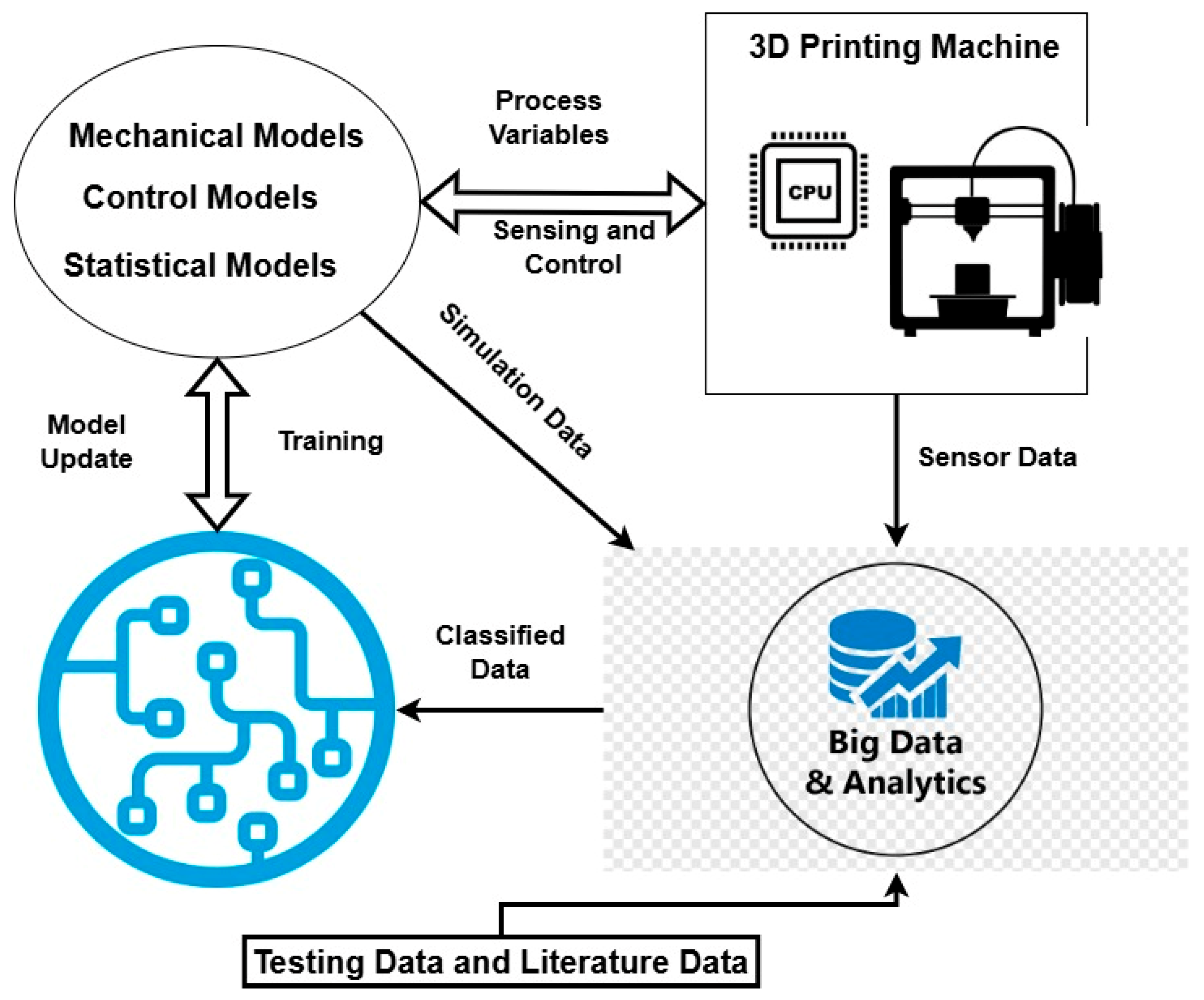
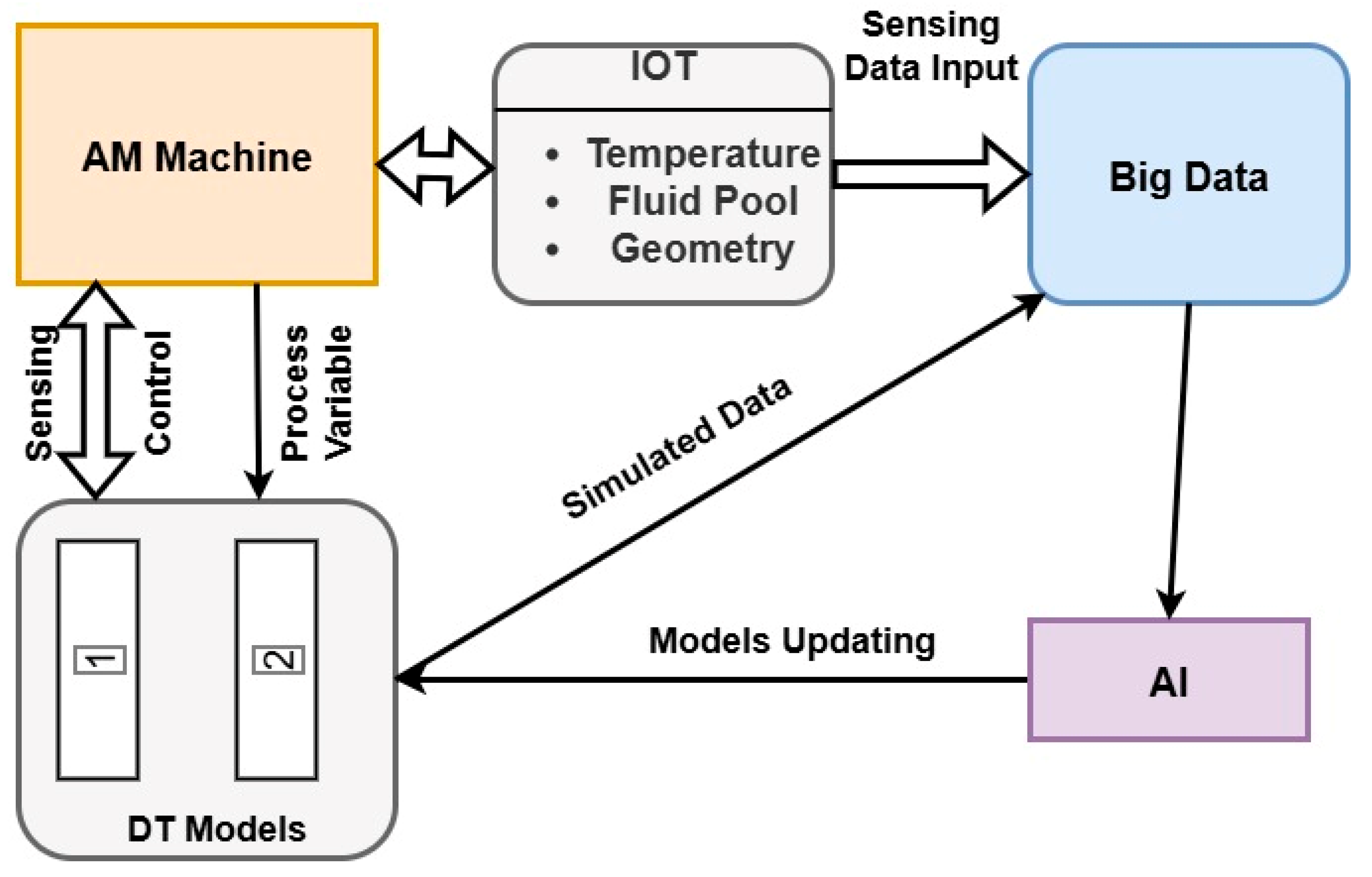
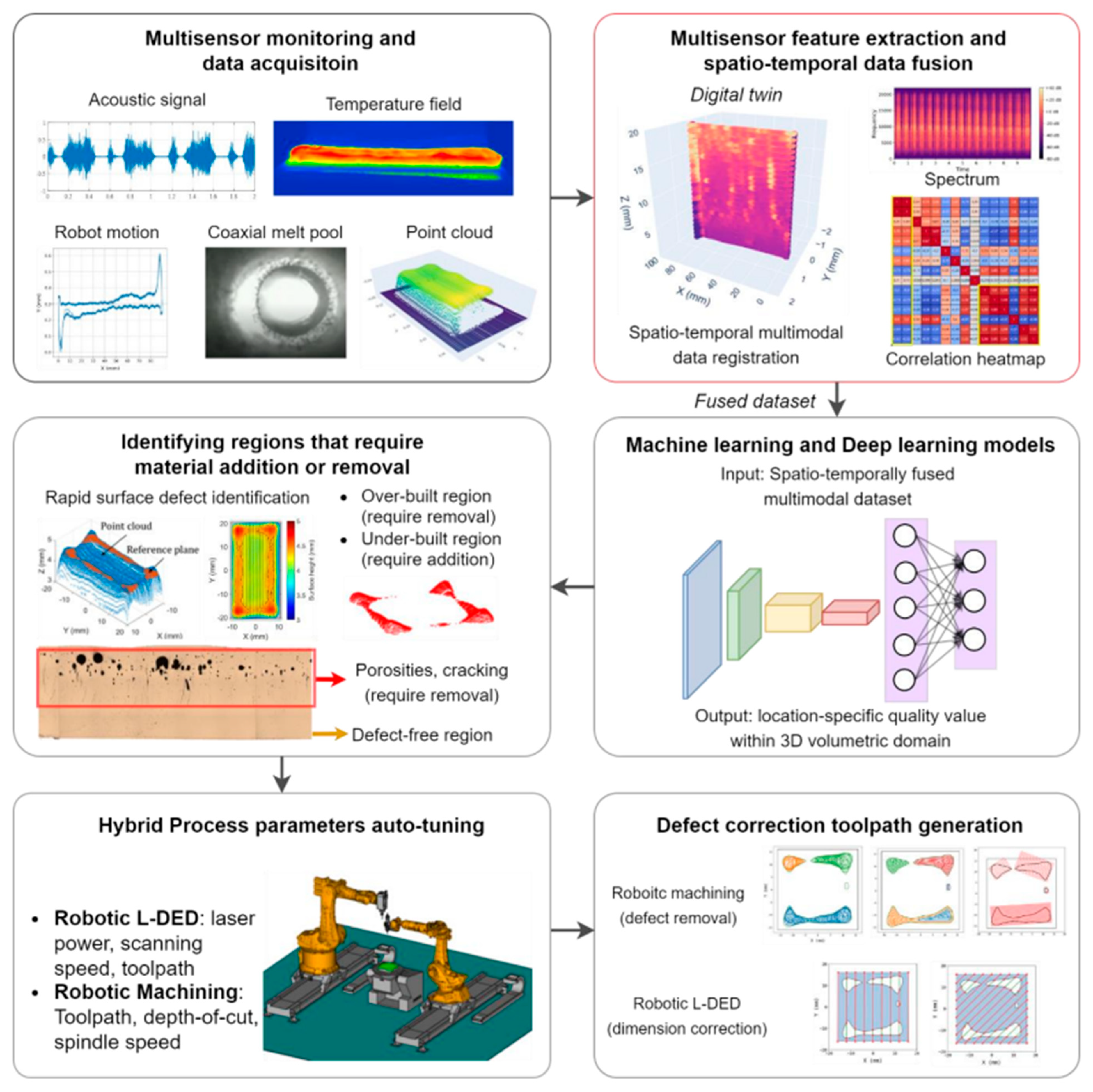
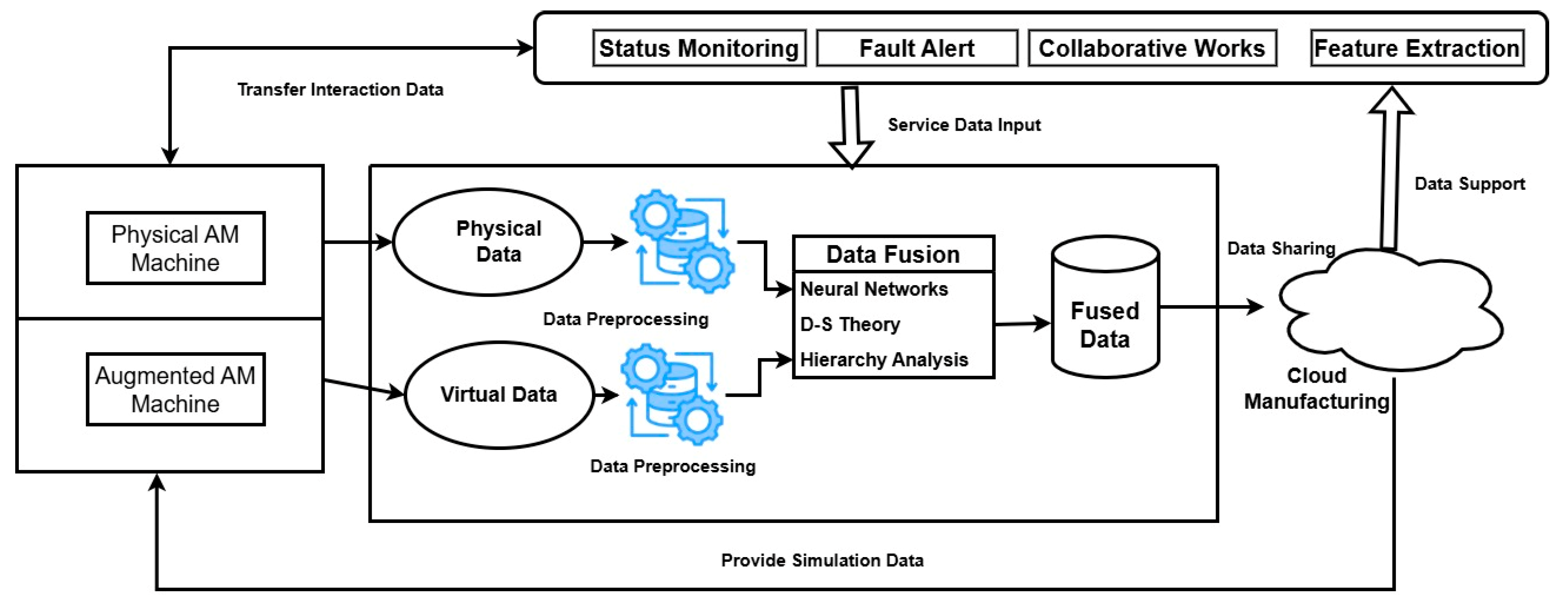

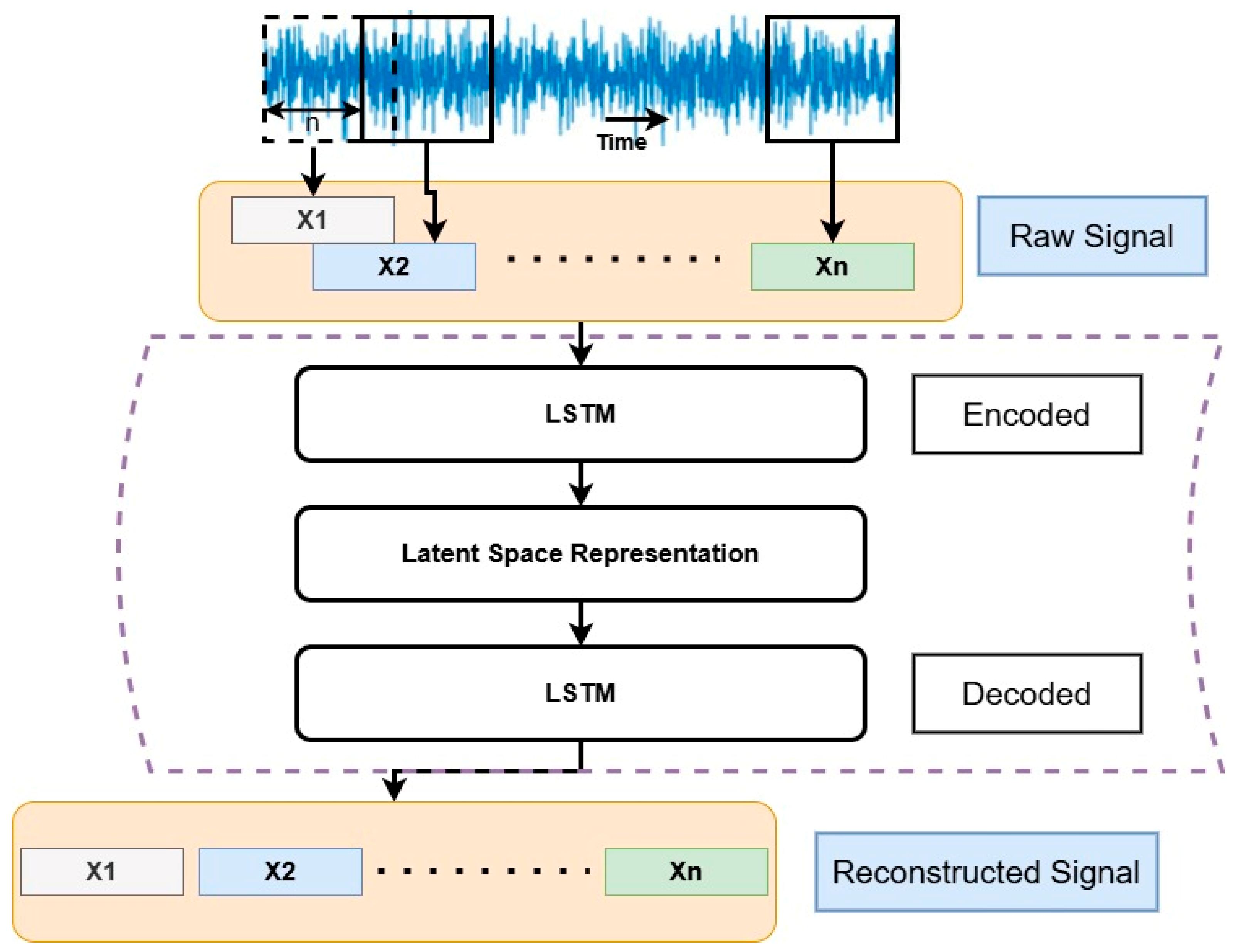
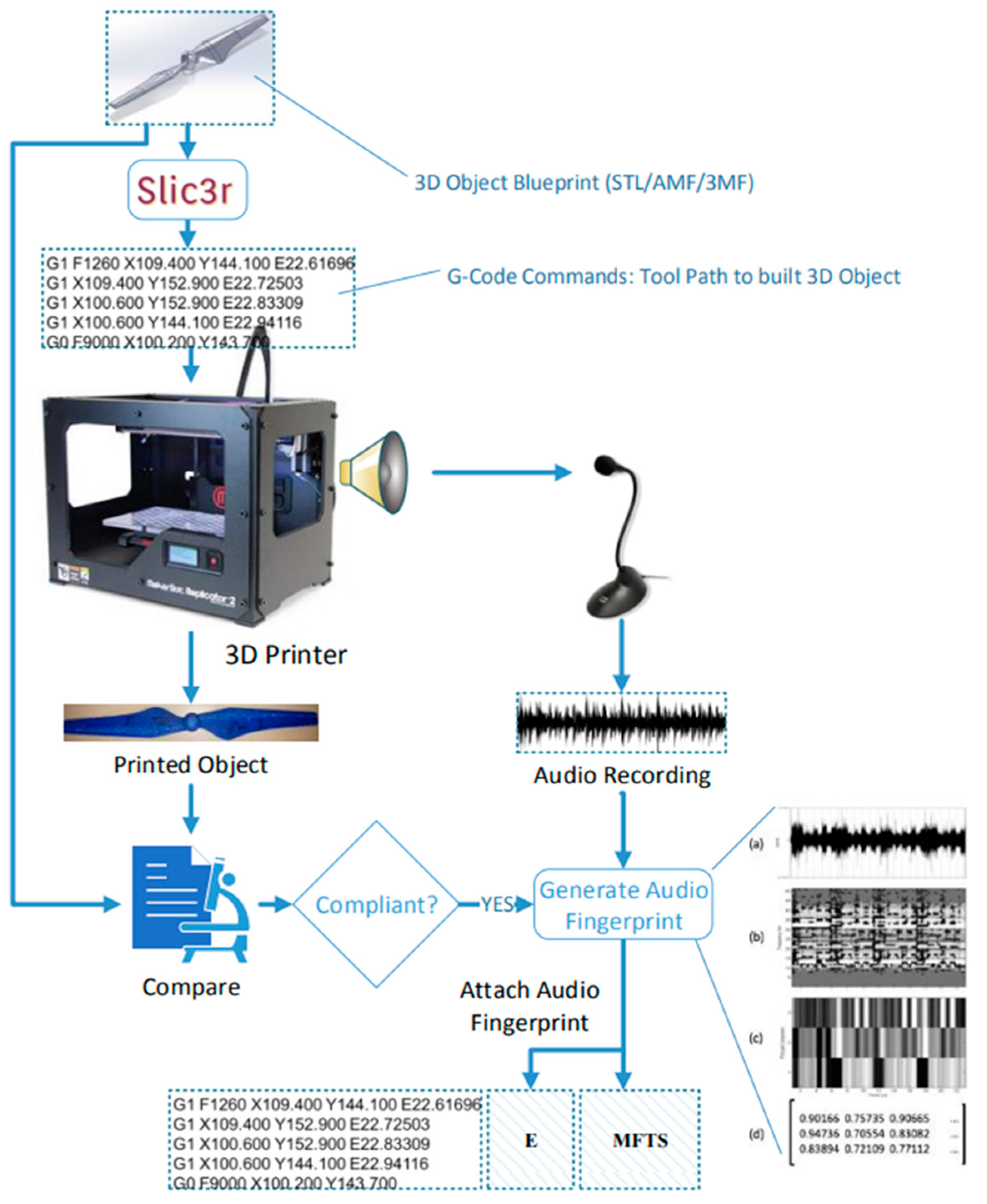

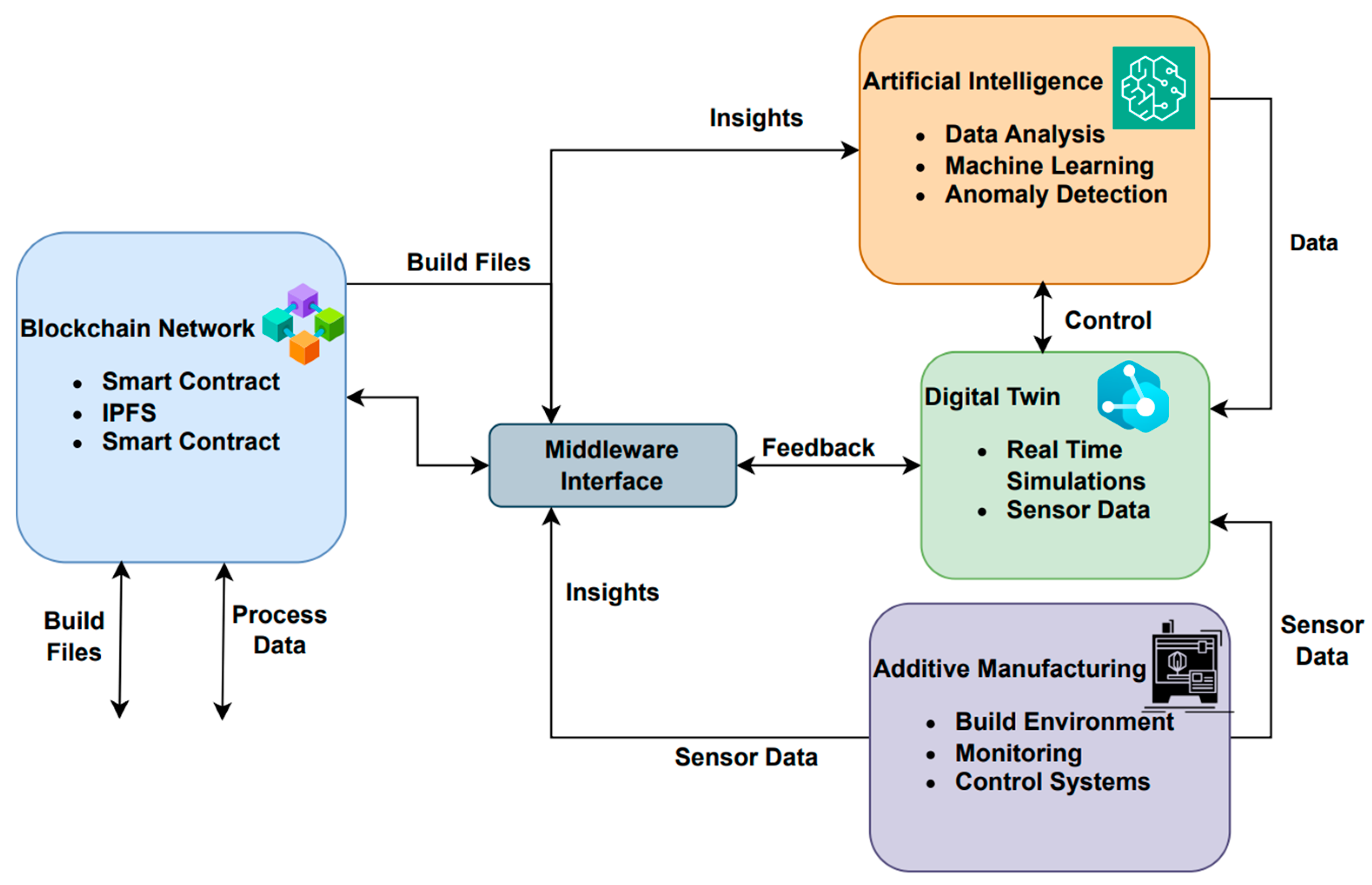
| Reference | Contributions | Future Scope |
|---|---|---|
| [15] |
| A single in situ sensor monitors only temperature distribution but additional process parameters such as laser power, scan speed, layer thickness etc., can extend the accuracy of flaw detection across various AM methods |
| [17] |
| Advanced AI and ML Integration with cyber-physical systems can improve real-time data analytics capabilities to facilitate predictive insights |
| [16] |
| The DT-enabled collaborative data management system can have ML-enabled advanced data analytics developed and implemented and applied in it |
| [40] |
| Implementing predictive models that can adapt in real time to changing conditions during the AM process is a significant challenge. It needs more validation and a verification process |
| [41] |
| The development of a comprehensive database and quantitative study of solidification texture can be explored |
| [20] |
| Enhanced data integration and open-source collaboration can improve the DT applications in AM |
| [42] |
| To improve the AM process chain, it is crucial to guarantee the validity and verifiability of the possible basic self-learning strategies as well as to better control data |
| Reference | AI Model | Contribution in AM (What They Did and What Are the Results) |
|---|---|---|
| [58] | ANN | AI into AM, leading to the development of closed-loop AM systems and DTs |
| [59] | Deep learning | A smart AM framework based on cloud-edge computing |
| [60] | ML | an innovative approach for online quality monitoring of AM employing acoustic emissions |
| [61] | AI | The osmotic manufacturing method was proposed as a concept to apply additive manufacturing techniques together with graph theory |
| [62] | Deep learning | A real-time computing-based self-monitoring system has been designed to classify the several degrees of delamination that could arise in a printed part |
| [63] | ML and Deep learning | An overview of AI in AM for a closed-loop system is presented |
| [64] | AI | Shows how artificial intelligence may increase design efficiency, help discover materials, maximize additive manufacturing techniques, and guarantee the quality of outputs generated by AM |
| [65] | A generalizable AI | A fully automated workflow across several AM systems should be used for the aim of supporting quick autonomous process parameter discovery and/or enhanced scientific understanding |
| [66] | AI | It speeds up simulations, improves the selection of materials, facilitates the design of novel structures with multiple functionalities, and cuts down on both time and money spending |
| Major Attacks | Subcategory Attack | Attack Model | Existing Solutions | References |
|---|---|---|---|---|
| Hardware Attacks | Side channel attacks | Acoustic Analysis, Electromagnetic Attacks, Power Analysis, Data Residuals, Environmental Exploits, Trimming Exploits, Cache Side-Channel, Differential Faults |
| [79,80,81,82,83,84,85,86,87,88,89,90,91] |
| Physical attacks | Physical Damage, Chip Decapsulation, Node Jamming, Node Tampering, Fake Node Injection, Code Injection, Sleep Deprivation Attack RF Interference | |||
| Network attacks | Outage attacks, DoS, tag cloning, camouflage, Man in the Middle, micro probing, traffic analysis, object replication | |||
| Data Attacks | Data exposure, leakage, loss, and scavenging; account hijacking; brute force; hash collision; malicious VM (virtual machine); and VM hopping | |||
| Software Attacks | Firmware attacks | Malware, reverse engineering, control hijacking, eavesdropping | ||
| Operating system attacks | Malware, worm, virus, Trojan, phishing, brute force, back door | |||
| Web application attacks | Malware, spyware, DDoS, pathbased DoS, reprogram attacks, malicious code injection, exploitation for reconfiguration |
| Reference | Attack Type | Detection Method | Result |
|---|---|---|---|
| [92] | Malicious void Consequence | The effect on the mechanical strength of a printed specimen was investigated by means of a “printed void” | 14% reduction in yield load |
| [93] | Dimensions Change | Developed the Bayesian game, computing Bayes–Nash equilibria | Operators under attack were not aware of dimensional change without reminding |
| [94] | Printing orientation | Mechanical testing, finite element analysis, and ultrasonic inspection | Strength, failure strain reduction |
| [78] | Malicious void Consequence | Presented DTs utilizing data-driven ML models, and physics-based models | Drone propeller fatigue life reduction |
| [95] | Inside the hole of a solid block |
|
|
| [82] | Different infill defect patterns | RNN, Random Forest, and anomaly detection | The accuracy of anomaly detection is 96.6% |
| [96] | Alternation of G code | Audio fingerprint comparison | The detection rate of the deviation at the time of its occurrence was 100% |
| [97] | Vulnerability in critical components named Gear and Wrench | ML Model | Proposed robust detection systems to prevent structural failures |
Disclaimer/Publisher’s Note: The statements, opinions and data contained in all publications are solely those of the individual author(s) and contributor(s) and not of MDPI and/or the editor(s). MDPI and/or the editor(s) disclaim responsibility for any injury to people or property resulting from any ideas, methods, instructions or products referred to in the content. |
© 2025 by the authors. Licensee MDPI, Basel, Switzerland. This article is an open access article distributed under the terms and conditions of the Creative Commons Attribution (CC BY) license (https://creativecommons.org/licenses/by/4.0/).
Share and Cite
Ahmmed, M.S.; Khan, L.; Mahmood, M.A.; Liou, F. Digital Twins, AI, and Cybersecurity in Additive Manufacturing: A Comprehensive Review of Current Trends and Challenges. Machines 2025, 13, 691. https://doi.org/10.3390/machines13080691
Ahmmed MS, Khan L, Mahmood MA, Liou F. Digital Twins, AI, and Cybersecurity in Additive Manufacturing: A Comprehensive Review of Current Trends and Challenges. Machines. 2025; 13(8):691. https://doi.org/10.3390/machines13080691
Chicago/Turabian StyleAhmmed, Md Sazol, Laraib Khan, Muhammad Arif Mahmood, and Frank Liou. 2025. "Digital Twins, AI, and Cybersecurity in Additive Manufacturing: A Comprehensive Review of Current Trends and Challenges" Machines 13, no. 8: 691. https://doi.org/10.3390/machines13080691
APA StyleAhmmed, M. S., Khan, L., Mahmood, M. A., & Liou, F. (2025). Digital Twins, AI, and Cybersecurity in Additive Manufacturing: A Comprehensive Review of Current Trends and Challenges. Machines, 13(8), 691. https://doi.org/10.3390/machines13080691







